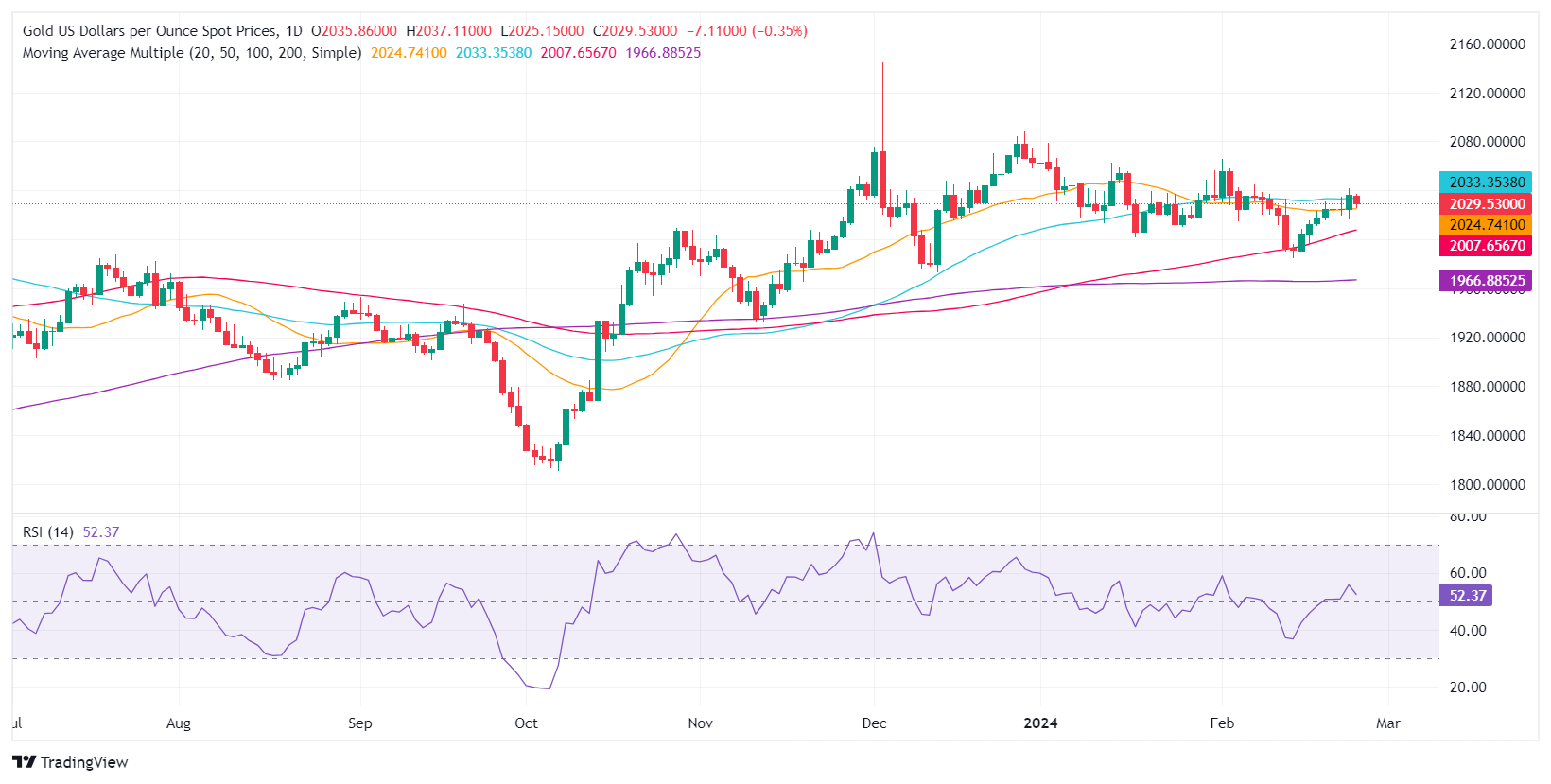Gold price dips after hitting 50-day SMA, rising US yields challenge rally
- Gold retreats to $2,026.93, facing pressure from a strengthening US Dollar and Treasury yield uptick.
- Market reevaluates Fed rate cut timeline with June odds at 50% for a potential easing.
- The US 10-year Treasury yield hovering around YTD highs keeps Gold’s price capped.
Gold price retraces after hitting the 50-day Simple Moving Average (SMA) at $2,033.67 during the European session and is down 0.40% as the Greenback (USD) dives. However, a rise in the US 10-year Treasury yield and traders trimming their odds of a dovish US Federal Reserve (Fed) sponsored a leg down in the non-yielding metal. The XAU/USD trades at $2,026.93 after hitting a high of $2,037.07.
Sentiment remains mixed, though tilted slightly negative, favoring the US Dollar. Interest rate speculators have priced out a Fed rate cut in March and May. For June, the odds of a quarter of a percentage point rate cut are at 50%. The US 10-year Treasury note climbs four-and-a-half basis points to 4.295%, shy of reaching the year-to-date (YTD) high of 4.354%, though keeping the yellow metal pressured, as investors align themselves with Fed officials’ posture of three rate cuts toward the end of 2024.
Daily digest market movers: Gold advance capped by the rise of US yields
- Data-wise, US New Home Sales rose by 1.5% from 0.651M to 0.661M, less than the 0.68M expected.
- The Dallas Fed Manufacturing Index for February contracted -11.3 though it improved compared to January’s -27.4 shrinkage, suggesting that business activity is recovering.
- The January minutes from the Federal Open Market Committee (FOMC) reveal that policymakers are cautious about reducing interest rates, mainly due to a recent uptick in inflation measures. While recognizing that the risks associated with meeting their dual mandates of price stability and maximum employment are becoming more balanced, the Fed intends to stay "highly attentive" to inflation. This focus comes even as they acknowledge that economic risks are skewed toward a downturn.
- Besides that, the US labor market remains strong after the latest Initial Jobless Claims data saw fewer Americans applying for unemployment benefits.
- US business activity moderated in February, revealed S&P Global. The Services and Composite Indices expanded below the previous month’s reading, though Manufacturing surprisingly jumped, exiting contractionary territory.
- Investors are pricing in 85 basis points of easing throughout 2024.
- The US Dollar Index, tracking the performance of the US Dollar against a basket of six major currencies, is currently trading near 103.84, down 0.12%.
- New York Fed President John Williams said the Fed is on track to cut interest rates “later this year.” He noted that the progress of inflation toward the central bank's 2% target would be “bumpy,” but overall the economy is headed “in the right direction.”
Technical analysis: Gold fails to cling above 50-day SMA as sellers move in

Monday sees a repeat of Friday’s note: “Gold has shifted to a neutral-upwards bias as it hurdles the 50-day Simple Moving Average (SMA).”
Even though XAU/USD has failed to cling above the 50-day SMA, the bias is intact unless Gold falls below the February 16 swing low of $2,016.15, which would exacerbate a challenge of the October 27 daily high-turned-support at $2,009.42. Once cleared, that will expose key technical support levels, like the 100-day SMA at $2,007.82, followed by the 200-day SMA at $1,966.79.
On the flip side, buyers dragging the XAU/USD spot price above the 50-day SMA could pave the way to challenge the $2,050 figure. Once those levels are cleared, up next would be the February 1 high at $2,065.60, ahead of the December 28 high at $2,088.48.
Gold FAQs
Why do people invest in Gold?
Gold has played a key role in human’s history as it has been widely used as a store of value and medium of exchange. Currently, apart from its shine and usage for jewelry, the precious metal is widely seen as a safe-haven asset, meaning that it is considered a good investment during turbulent times. Gold is also widely seen as a hedge against inflation and against depreciating currencies as it doesn’t rely on any specific issuer or government.
Who buys the most Gold?
Central banks are the biggest Gold holders. In their aim to support their currencies in turbulent times, central banks tend to diversify their reserves and buy Gold to improve the perceived strength of the economy and the currency. High Gold reserves can be a source of trust for a country’s solvency. Central banks added 1,136 tonnes of Gold worth around $70 billion to their reserves in 2022, according to data from the World Gold Council. This is the highest yearly purchase since records began. Central banks from emerging economies such as China, India and Turkey are quickly increasing their Gold reserves.
How is Gold correlated with other assets?
Gold has an inverse correlation with the US Dollar and US Treasuries, which are both major reserve and safe-haven assets. When the Dollar depreciates, Gold tends to rise, enabling investors and central banks to diversify their assets in turbulent times. Gold is also inversely correlated with risk assets. A rally in the stock market tends to weaken Gold price, while sell-offs in riskier markets tend to favor the precious metal.
What does the price of Gold depend on?
The price can move due to a wide range of factors. Geopolitical instability or fears of a deep recession can quickly make Gold price escalate due to its safe-haven status. As a yield-less asset, Gold tends to rise with lower interest rates, while higher cost of money usually weighs down on the yellow metal. Still, most moves depend on how the US Dollar (USD) behaves as the asset is priced in dollars (XAU/USD). A strong Dollar tends to keep the price of Gold controlled, whereas a weaker Dollar is likely to push Gold prices up.
